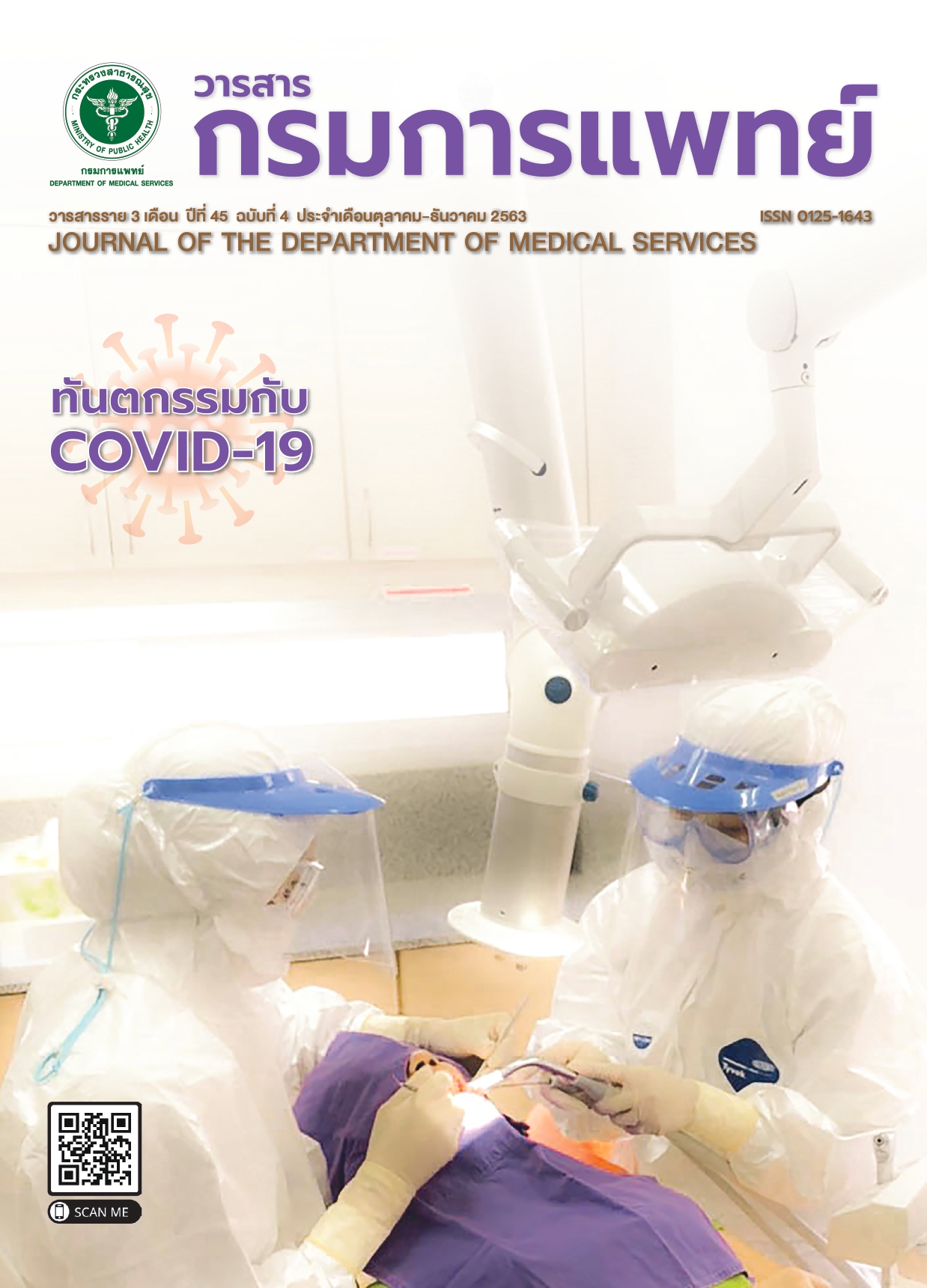Comparison between Double-Guidewire and Single-Guidewire Techniques to Serum Amylase and Lipase Levels at 24 Hours after Endoscopic Retrograde Cholangiopancreatography
Keywords:
Double-guidewire technique, ERCP, Amylase, LipaseAbstract
Background : Serum amylase and lipase are frequently checked for evaluating acute pancreatitis in patients who developed abdominal pain after ERCP procedure. In difficult cases of ERCP, double-guidewire technique would be recommended to increase success rate of cannulation but it might affect on rising of serum amylase and lipase levels.
Objective : This study aims to comparison between double-guidewire technique (DGW) and single-guidewire technique (SGW) to serum amylase and lipase levels at 24 hours after ERCP.
Method : The study was observational analytic study in patients who visited at National Cancer Institute and Lopburi Cancer Hospital from February 2019 to February 2020 for ERCP.
Result : All 78 patients were included, most of indication for ERCP is malignant biliary tract obstruction about 62.8%. Amylase level rising above 3 times of normal limit was statistically significant in DGW group (53.8% and 23.5% respectively, p=0.008) nevertheless no significant difference of the lipase level between the two groups. Regards to multiple logistic regression, DGW group showed correlation to rising amylase level than SGW group but statistically was not significant (OR 2.0, 95% CI = 0.61, 6.52, p = 0.252).
Conclusion : Double-guidewire technique group has many confounding factors that affect amylase level such as first episode of ERCP, cannulation times more than 10 minutes, and sphincterotomy. Therefore, DGW group showed statistically significant rising of amylase level at 24 hours compare to SGW group.
References
McCune WS, Shorb PE, Moscovitz H. Endoscopic cannulation of the ampulla of vater: a preliminary report. Ann Surg 1968;167:752-6.
Anderson MA, Fisher L, Jain R, Evans JA, Appalaneni V,Appalaneni V, et al. ASGE Standards of Practice Committee;2012.
Dumonceau JM, Andriulli A, Deviere J, Mariani A, Rigaux J, Baron TH, et al. European Society of GastrointestinalEndoscopy (ESGE) Guideline: prophylaxis of post-ERCP pancreatitis. Endoscopy 2010; 42:503-15.
Freeman ML, Guda NM. Prevention of post-ERCP pancreatitis:a comprehensive review. Gastrointest Endosc 2004; 59:845-64.
Cotton PB, Lehman G, Vennes J, Geenen JE, Russell RCG,Meyers WC, et al. Endoscopic sphincterotomy complications and their management: an attempt at consensus. Gastrointest Endosc 1991;37:383–93.
Testoni PA, Bagnolo F. Pain at 24 hours associated with amylase levels greater than 5 times the upper normal limit as the most reliable indicator of post-ERCP pancreatitis.Gastrointest Endosc 2001; 53:33-9.
Cavallini G, Tittobello A, Frulloni L, Masci E, Mariana A, Di Francesco V. Gabexate for the prevention of pancreatic damage related to endoscopic retrograde cholangiopancreatography.N Engl J Med 1996; 335:919–28.
Freeman ML, Nelson DB, Sherman S, Haber GB, Herman ME, Dorsher PJ, et al. Complications of endoscopic biliary sphincterotomy. N Engl J Med 1996; 335:909–18.
Barkin JS, Casal GL, Reiner DK, Goldberg RI, Phillips RS, Kaplan S. A comparative study of contrast agents for endoscopic retrograde pancreatography. Am J Gastroenterol 1991; 86:1437–41.
Elta GH, Barnett JL, Wille RT, Brown KA, Chey WD, Scheiman JM. Pure cut electrocautery current for sphincterotomy causes less post-procedure pancreatitis than blended current.Gastrointest Endosc 1998; 7:149–53.
Wang P, Li ZS, Liu F, Ren X, Lu NH, Fan ZN, et al. Risk factors for ERCP-related complications: a prospective multicenter study. Am J Gastroenterol 2009; 104:31-40.
He QB, Xu T, Wang J, Li YH, Wang L, Zou XP. Risk factors for post-ERCP pancreatitis and hyperamylasemia: a retrospective single-center study. J Dig Dis 2015; 16:471-8.
Fabián Rodrigo Del Castillo Rangel, Lázaro Antonio Arango Molano. Determining Frequency of Hyperamylasemia and Pancreatitis in Patients after Endoscopic Retrograde Cholangiopancreatography. Rev Col Gastroenterol 2017;32:220-25.
Kasmin FE, Cohen D, Batra S, Cohen SA, Siegel JH. Needle-knife sphincterotomy in a tertiary referral center: efficacy and complications. Gastrointestinal Endoscopy 1996; 44:48-53.
Larkin CJ, Huibregtse K. Precut sphincterotomy: indications,pitfalls, and complications. Curr Gastroenterol Rep 2001;3:147–53.
Testoni PA, Mariani A, Aabakken L, Arvanitakis M, Bories E, Costamagna G, et al. Papillary cannulation andsphincterotomy techniques at ERCP: European Society of Gastrointestinal Endoscopy (ESGE) Clinical Guideline.Endoscopy 2016; 48:657-83.
Hayashi S, Nishida T, Shimakoshi H, Shimoda A, Amano T,Sugimoto A, et al. Combination of two-hour post-endoscopic retrograde cholangiopancreatography amylase levels and cannulation times is useful for predicting post-endoscopic retrograde cholangiopancreatography pancreatitis. World J Gastrointest Endosc 2016; 8:777-84.
Minakari M, Sebghatollahi V, Sattari M, Fahami E. Serum amylase and lipase levels for prediction of postendoscopic retrograde cholangiopancreatography pancreatitis. J Res Med Sci 2018; 23:54.
Angsuwatcharakon P, Rerknimitr R, Ridtitid W, Ponauthai Y,Kullavanijaya P. Success rate and cannulation time between precut sphincterotomy and double-guidewire technique in truly difficult biliary cannulation. J Gastroenterol Hepatol2012;27:356–61.
Downloads
Published
How to Cite
Issue
Section
License
บทความที่ได้รับการตีพิมพ์เป็นลิขสิทธิ์ของกรมการแพทย์ กระทรวงสาธารณสุข
ข้อความและข้อคิดเห็นต่างๆ เป็นของผู้เขียนบทความ ไม่ใช่ความเห็นของกองบรรณาธิการหรือของวารสารกรมการแพทย์



